And here is the recipe for kitty litter cake ...
Here are some more cat pictures:




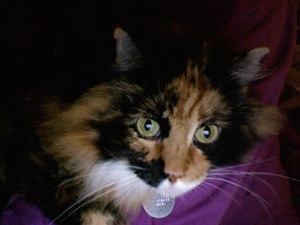







At right is Penelope, also known as Penster, or just Pen. She used to live in the household of a friend of mine who traveled a lot; I took care of her then. (The neighbors all knew me as Mister Feed-the-Cats.) Alas, my friend was unable to keep her, so now she lives with me.
Penelopuss has the most incredible blue eyes. She is full-grown but small. Most of her is white. She is a semi-longhair, mostly white. She has lots of Siamese in her ancestry: That makes her smart and vocal. She is very friendly, but determined to get her own way in all things. She will complain loudly if matters are not going according to plan -- that’s her plan, of course.
Penelope particularly likes to be scratched under the chin.
At right is a more recent image of Penelope.
At left is Jack, also known as Jack-a-Boo. He lived in the same household as Penelope. He is a slate-gray shorthair with white feet, with more white on his chest, belly, throat, and face. He is a real rascal -- a true trickster of a cat -- and cannot be deterred from being overwhelmingly affectionate at all possible times.
Poor Jack: He wanted so much to be friends with Penelope, but he insisted on being more social than she wants, so she chased him off. He was a real gentleman about being rejected, and deferred to her wishes, but he was full of incurable boundless optimism, so he always tried again -- too soon, and with too much enthusiasm.
Jack particularly likes to play with anything that even thinks about moving.


At right is Blackie Diamond, or Blackie for short. She lives with another friend of mine. She is a tiny coal-black shorthair who is very shy: It took an amazing amount of effort to coax her sufficiently into view to take this picture.
Blackie Diamond and Marble (below) were living wild in a vacant lot and parking lot when my friend took them in. They are too different in ages to be litter mates, and Blackie Diamond was not grown up enough to be Marble’s mate. Notwithstanding, they were hanging out together, and appeared inseparable.
At left is Marble, who lives in the same household as Blackie Diamond. He is a semi-longhair, with a wonderful mottled gray-black coat pattern, and is very friendly, and looks a little startled in this image because of the bright light of the flash.
Marble and Blackie Diamond continue to be best pals as they live happily indoors at my friend’s apartment.

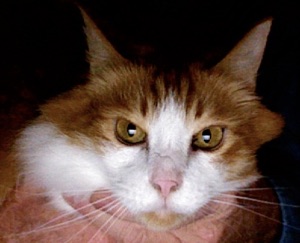
At left is Priscilla, now deceased. She was a dark calico, named because she was prissy -- she was a babe and she knew it. She was very jealous of my guitar, and learned to wrap her tail around the guitar neck to mute the strings. But she was a sweety pie, so that’s okay.
Priscilla and Willoughby look flustered here. The images were taken with my Macintosh’s webcam. The cats were not sure what it was: They believe that anything that takes up time that could be spent petting cats is obviously evil. Besides, the Mac flashes the screen bright white when you take a webcam image, and that’s scary.
At right is Willoughby, Priscilla’s kitten, now deceased. He was named after a Jane Austen character. He was fey. Even full grown, he could do a standing high-jump from the floor and get a paw to my eyebrows -- 150 centimeters up. He was also jealous of my guitar, and bumped my elbow when I played it. But he was cute, so that’ was okay.
I found Pris and Will near a road in a local state park late at night. Someone had abandoned them in coyote country. So I took them home. I doubt they would have lasted till morning. Willoughby couldn’t have been more than a month or two old.
A more recent picture of Willoughby is at right. He is older now -- he was born in 2002 -- and can no longer do standing high jumps, but he is still chipper, cute, and affectionate.

At left is Elvis, now deceased. I acquired him pre-named, when I already had Priscilla, so for a while I had “Elvis and Priscilla”, though Priscilla was not “that” Priscilla.
He was the first cat to get comfortable with me playing guitar. He would curl up by my thigh, purring, as I practiced. I used to say he was channeling, though those who think the real Elvis isn’t dead yet might disagree.
The day Elvis died, I picked up my guitar, and for the first time ever, successfully played the toughest piece I have ever attempted -- one I had been practicing for over two years. So maybe he was channeling after all, and maybe he still is.
(The piece was Jorma Kaukonen’s “Embryonic Journey” -- with tablature from the Jefferson Airplane album, “Surrealistic Pillow”.)




At right is Knightley, now deceased. I named him for a Jane Austen character because he was such a gentleman. He was an adult from a local feral colony that is well cared for, but became extremely affectionate -- a real cuddle junky, who liked to sleep as close to my head as he could get. I suspect he was abandoned at the colony, not born there.
Kinghtley was small and rather cobby. His coat was a good shade of what cat fanciers call “blue”. His voice sounded remarkably like that of a human infant. I always wondered the neighbors thought.
At left is Pandora, my favorite cat in a long, long, time. When I took her in, she was a young feral adult from a local colony, who was used to people feeding her. She is a wonderful companion: She has a mind of her own and has no scruples about being feisty to get her way -- my hands were in ribbons for the first few months -- but she is very affectionate on her own terms, and loves to play. “Pandora” is a good name, for after all the fuss, her last gift, of love, was indeed something wonderful.
Pandora likes to be brushed. Her coat is an excellent example of what cat people call “blue”. Her favorite toy is a ball-point pen.
Sometimes I call her “Pandybrat”, or just plain “Pan”. She and Fuzzy Britches have become fast friends and occasionally team up on mischief.
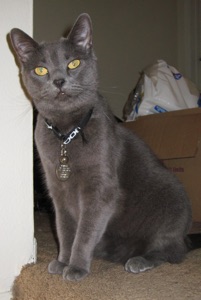
At right is Fuzzy Britches, taken in as a year-old feral from a local colony. She was born there, but became well socialized because the people who fed the colony thought she was cute and fussed over her. Some called her “the fuzzy one”, hence her name. (You who get the Heinlein reference, have no fear: She is spayed.) The curls of white hair growing out of her ears give her a somewhat Mephistophelean appearance.
Fuzz is playful and active. I have to be careful not to trip over her. I took her in on Saint Patrick’s day, 2016, and very nearly named her “Leprechaun”.

At left is Dapple, taken in as a young feral adult from a local colony. She would be a mostly-black tortoiseshell, but she expresses a recessive gene that makes black fur grey and orange fur cream-colored; thus she is a blue-cream tortoiseshell. Her coat resembles the dappled pattern of sunlight falling through leaves onto a forest floor.
At first she was easily frightened, but she has now relaxed. She loves attention and will purr long and loud when carefully skritched.


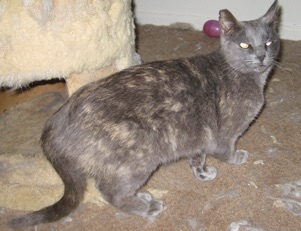
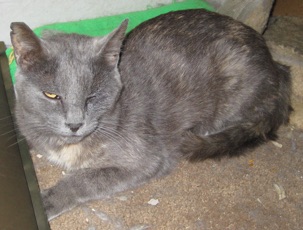




At right is Weasel, now deceased, also from the local feral colony. She looked a lot like a slightly smaller version of Fuzzy Britches -- though she lacked Fuzzy’s smoke-like ear hairs and white chest spot. I suspect they are related.
Weasel was well-named -- a scamp if ever there was one. She was shy at first: She worried about what was going to happen when I picked her up. She got over that and grew to love attention, but for a while she liked it more after I put her back down. She made cute short mewing noises when she was worried, and so got lots of attention.
She ended up liking to sleep next to my head on the pillow. I miss her.
At left is Petite. She is from the local feral colony, but was not a long-time resident there: She showed up very affectionate and knowing about people, and was obviously a former house cat that someone had thrown away.
Petite is sweet and affectionate; she is a serious lap cat and likes to sleep curled up on top of me when I am in bed myself. She was not fully grown when I took her in and was well named, but has put on weight and bulk since then.
She is also very persistent, particularly about jumping up onto the computer keyboard while I am typing. Once she did that twelve times in a row, so I finally picked her up and cuddled her.
At right is Puccini, now deceased. I was feeding cats at the local feral colony when a car drove up and a little girl got out with a double handful of kitten that her family had found in a local store parking lot and could not keep themselves. He was about two months old, and very loving, gentle and affectionate -- he obviously had had a home. So I took him in, and I am glad I did.
Puccini was cute and affectionate enough that even my veterinarian made goo-goo eyes at him. My other cats all liked him as well. He was named because he was given to creating loud dramatic vocal compositions at times.
He was so tiny I called him “Weeny Puccini” or “Puccaweeny” (“Pooch-a-weeny”), but he grew up to be huge. Later I called him “Pooch” for short – or “Puccawiggle” (“Pooch-a-wiggle”), since he wiggled a lot.
He died suddenly, with no warning, of heart failure. He was not quite six years old.


To the right is Rhubarb, now deceased, a long-time resident at the local feral colony. Everyone said “He is a great cat, someone should take him in.” So I did. They were right: He was a great affable lump of a cat. He was huge – over 5 Kg. Some of my other cats from the same colony recognized him, but Puccini, who was still a kitten, was scared at first. Then three days later I found them eating side by side from the same bowl.
His name at the colony was “Roo”. No one knew why. I thought “Rhubarb” fit his character, and besides, what fun having a cat named after a vegetable! He sometimes sat up on his hind legs and begged when he was hungry, so maybe it was originally “Kangaroo”.

At left is Marble, also from the feral colony. She is another blue-cream tortoise-shell, like Dapple (described below). She has an unusual and lovely face.
She was extraordinarily shy at the colony: It took months before she would come close, but as soon as I could touch her I found I could pick her up and cuddle her with no objection on her part. She is without question the gentlest cat I have ever encountered.
In this image she is sitting on the sill of a window, with vertical blinds at right and a piece of aluminum foil (to keep the inside cooler) taped to the glass at left. Marble likes the window sill and spends a lot of time there: She is one of my sunshine girls. (The other is Weasel.)
This “Marble” is different from the other “Marble”, listed far below.

At left is Masquerade, now deceased, a very pretty Siamese mix who showed up nearly starving at the local feral colony. She was shy and gentle and liked to be cuddled. She was also my most expensive cat to date – knock on wood: She got a severe bacterial infection and had to have her spleen removed. I of course thought she was worth it. Most nights she slept by my feet at the foot of my bed.
Everyone who saw her commented on how pretty she was.
Since she was shy, I sometimes called her “Mousequerade”.

This is Naiad, a seal point Siamese whom I rescued as a kitten. She was living in a sewer – actually, the storm drain system under the parking lot where the local feral colony lives. One night I saw a tiny white kitten dash across the lot and round the corner of a building. I thought “There is no nope for her – she will be road kill soon,” but I left food anyway. A week later I saw her again, sitting near a storm drain entrance. As I approached she ducked into the drain, but I left food. A pattern emerged: I would leave food near a storm drain entrance and it would disappear after a while. Finally I found an entrance where it disappeared in less than 15 minutes, so I figured I had identified her home base. I got a trap and set it, and after less than an hour she was inside!
She was scrawny and covered with fleas, but completely tame. She wanted nothing more than to be picked up and petted and cuddled. She was obviously a house-raised kitten who knew about humans. Someone had thrown her away.
She is grown now and usually sleeps near my head on the bed. She purrs a lot, and insists on washing my face several times a day.

At left is Macaroon, now deceased, my most satisfying rescue to date. He was abandoned in the local colony and had not figured out where to go to be fed. The top image shows him just after rescue: He had fleas, lice, mange, two kinds of intestinal parasites, and was starving to death. He ate three pounds of wet cat food in the first two days after rescue. I named him for a chocolate-dipped coconut macaroon – black on top, white on the bottom, with a bit of reddish singed coconut (fur discolored from malnutrition) here and there.
The bottom image shows him six months later. He had put on a bit too much weight, but he deserved a chance to enjoy it. I sometimes called him “Megaroon”. though.
And oh, yes, he was perfectly gentle and affectionate once I took him in – another cat that had been thrown away.
By coincidence, he was sprawled on the computer desk in front of me when I first posted these pictures, all snug and sleepy.

This is Butterscotch, a rescue from a local feral colony, named for his coloring. His behavior suggests he was feral for a long time, and was perhaps born feral: He doesn’t mind being inside, doesn’t mind the other cats (most of whom he already knew in the colony, of course), and happily eats treats from my hand. He likes to be petted but does not like to be handled – a subtle difference. Notwithstanding, if I start to skritch his head, and he is in the right mood, he will lie down on the floor, roll on his back, and wriggle happily.
Sometimes he gets a little plump, and then I call him “Butterbear”, or even “Butterball”.

This is Socks, named for his white feet. He is a remarkable cat, a large, powerful tom from the local feral colony who was evidently not neutered till adulthood, for he is still a bit aggressive and territorial around other cats. (He gets time away from them to help relax.) What makes him special is the degree to which he has bonded with me: He follows me around, comes when called, loves to jump into my lap and tread and purr, and usually sleeps by my head at night. He likes to play rough with me, biting and using his claws, but never draws blood. I think he is like a big brother who punches your arm and wrestles you but wouldn’t actually hurt you for the world.
What is most remarkable is that I can console him when he is upset. When he growls or fusses about other cats, I can pick him up, pet him, and tell him it is okay, and he will relax. He may continue to fuss at the other cats while I am calming him down, but he does not get upset with me. Usually a cat upset with other cats will be upset and feisty with humans too, but not Socks.

At right is Elbows, so named because the dark stripes at her elbows are unusually prominent. She is the one cat I have whom I know was born in the wild: She was one of the last litter of the last unneutered female in the local colony. I have fed her essentially every day of her life since she was weaned, but was not able to take her in till she was a bit over two years old.
Given her feral history, she is quite wary around humans, and does not like to be handled. Fortunately, having fed her regularly for all of her life give me lots of credit: She is quite happy to take food or treats from my hand, and she does like to be petted.
Sometimes I call her E’Bows.
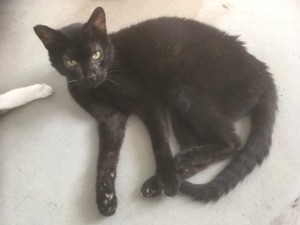
At left is Milk Drop – M.D. for short – now deceased. He had a tiny spot of white on his left flank, like a drop of milk. He was from the local feral colony and was quite wary when I took him in, but shaped up to be a nice cat: He got past the state where he was unwilling to be handled and finally let me pick him up to pet him. He was timid around several of my other cats, so I fed him separately so that he could eat his food in peace.

Here is Tammy, also known as Tamster the Hamster because she was given to running about at top speed for long periods of time as a kitten. She was abandoned at the local feral colony; I believe I took her in less than twenty-four hours later – she wasn’t hungry and was very friendly, I just picked her up.
She tends to bite when she wants attention, but purrs and wiggles when picked up and cuddled. Occasional taps on the nose seem to be curing her of the biting habit.

At left is Candle, a very dark tortoise-and-white, named because her sparse bright patches remind me of lights in the darkness. She was another abandoned kitten at the local feral colony, happy to be picked up and taken in. I had to keep her in a separate crate with Tammy (just below) for a while, and they bonded well together. Now she is yet another cat who likes to sleep beside me on the bed.

At right is Lady Jane, now deceased, who was named – obviously? – for Lady Jane Gray of the Avengers. She was very wild at the local feral colony; I had to feed her regularly for several years before I could touch her. I expected her to remain fey after I had taken her in, but what do you know? After a few weeks she was happily sleeping curled up by my side every night. She purred when touched, and nuzzled and licked my hands. She was a good old gentle gray cat, and I miss her.

This is Lilac, a very shy cat from the local feral colony. I named her because she reminded me of a cultivar of lilacs in which the flowers blended in with the foliage and did not stand out separately: She is that kind of shy.
Lilac is reluctant to be handled, but she seems to like me: When I do pick her up she is neither angry nor frightened. She seems to enjoy being cuddled and petted, and when she has had enough she departs leisurely rather than by jump-and-run. It probably helps that I have a several-year track record of making sure she is fed.
Cats to whom I belong, have belonged,
or ought to belong.
The question is not, can they reason? Nor, can they talk? But, can they suffer?
-- Jeremy Bentham, philosopher, 1748-1832.
To study independence, keep a cat.
To study diplomacy, keep two.
A cat is a magical creature, who can hold a human being spellbound
for hours with no more apparatus than a piece of string.
What it takes to be good at cat rescue is:
o A high pain threshold
o A poor sense of smell
o A great deal of patience
o A firm conviction that cat hair is a fashion accessory
o ... and it helps if you like cats ...
A dog who has got your back will fight to the death to protect you.
A cat who has got your back is hanging on with claws and enjoying the ride.
A principal purpose of cats is to afford humans
sufficient opportunity to practice humility.
Here is Salt, also from the local feral colony. She is basically solid black but has a sprinkling of white hairs, hence her name. She has some front teeth missing, and in consequence has the adorable habit of leaving her tongue stuck out a little way most of the time.
Salt is FIV-positive – that is sort of like human HIV though less contagious -- so out of an abundance of caution, I keep her in a room separate from the rest of my feline family. She is very mild-mannered, appreciates attention and reciprocates by snuggling and purring. I was going to say that that behavior pattern is not expected for ferals, but then I realized that nearly all of my “recovering ferals” are like that.


This is Sundae, now deceased, so named because the pattern of her coat resembled a scoop of vanilla ice cream with chocolate sauce poured over it. She was another former feral from the colony I help feed. She was shy at first, but soon moved from hiding under a chair to hanging out in the cat forest (a group of cat trees), and finally ended up sleeping next to me on my bed. She always trusted me – I generally get credit for having fed these cats for a long time.

Here is Crissy, now deceased. She was also from the feral colony that I have been helping to feed. Her eyes were different colors. When I took this image, she had been in my house less than two months and was still a little shy – she was hiding under a table in my bedroom. She did not stay there all the time, and was learning to come out to get her bowl of food at meal time. She eventually grew relaxed an confident enough not to hide all the time, and occasionally slept on the bed with other cats.
I acquired Sundae (below) and Crissy only a few weeks apart, and when both of them were introduced to my cat area (after some time being quarantined), they obviously recognized each other. They tended to hang out together, which was very cute.
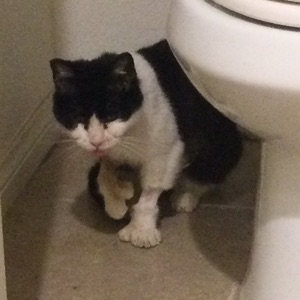
This is Polly, so named because she is a polydactyl – look at all those toes! She is another feral from the same colony as most of my other cats. Polly was captured while immobilized by a seizure of some kind, and spent a long time in intensive care at a veterinary hospital for diagnosis and treatment. She was so wary and trap-shy as to be impossible to capture previously, yet she turned out to be a real sweetie – she likes to cuddle and purrs when touched. She is a little doll, except that she does not like to take her anti-seizure medicine.
With the dark mask and the broad black marking on her back, she looks a little like Batman. Every cat owner should have a caped crusader in the house.
